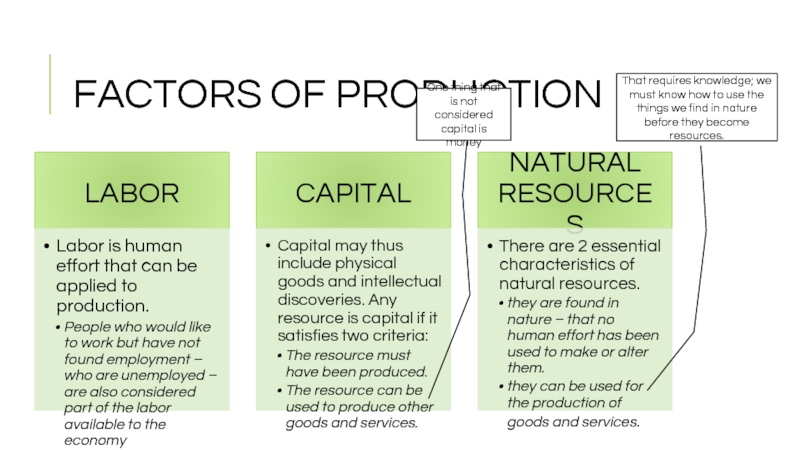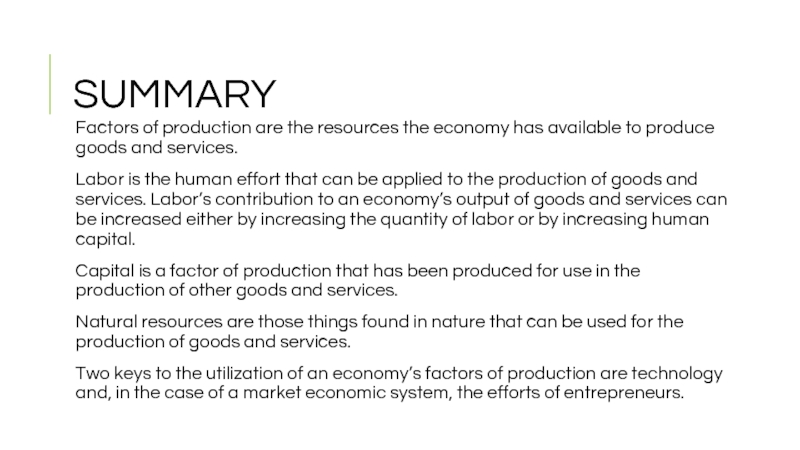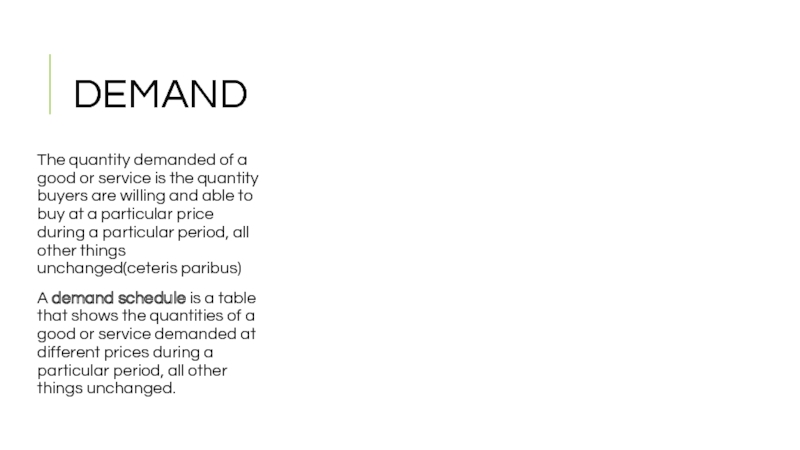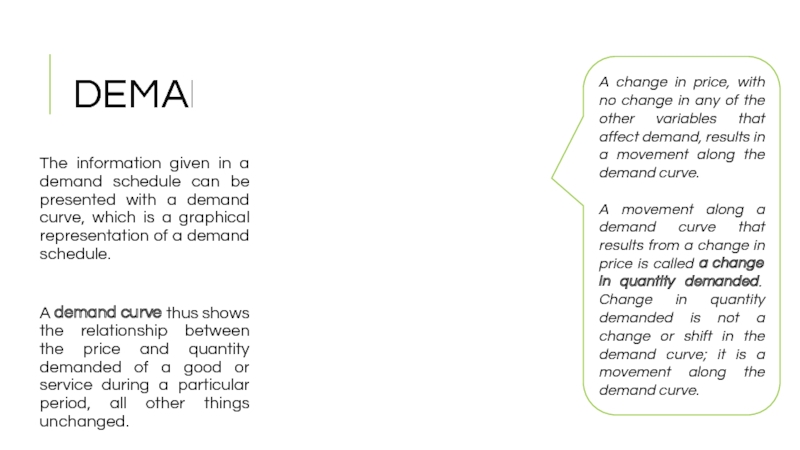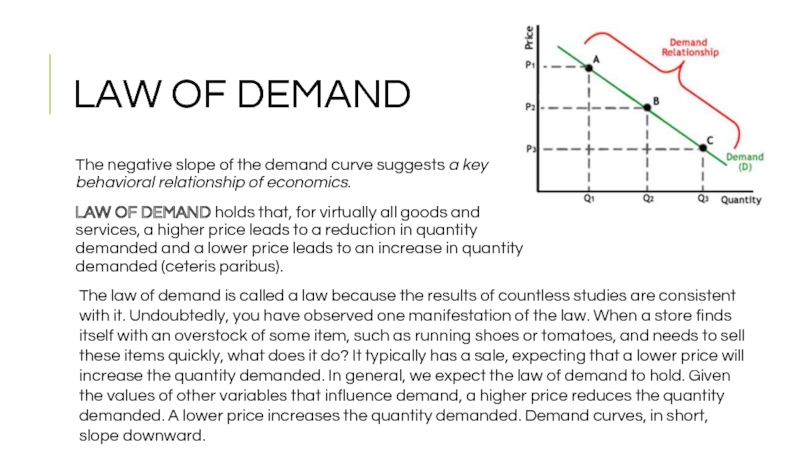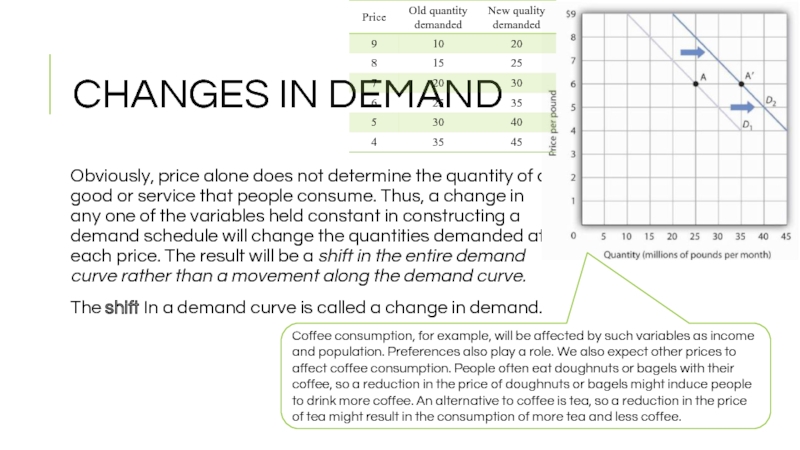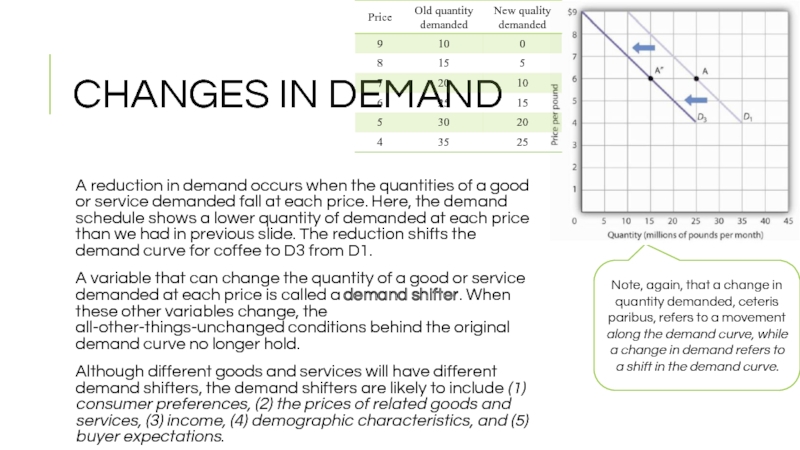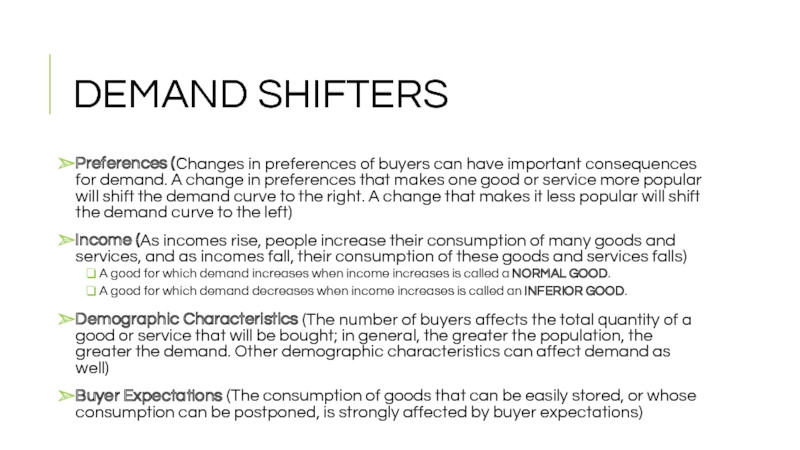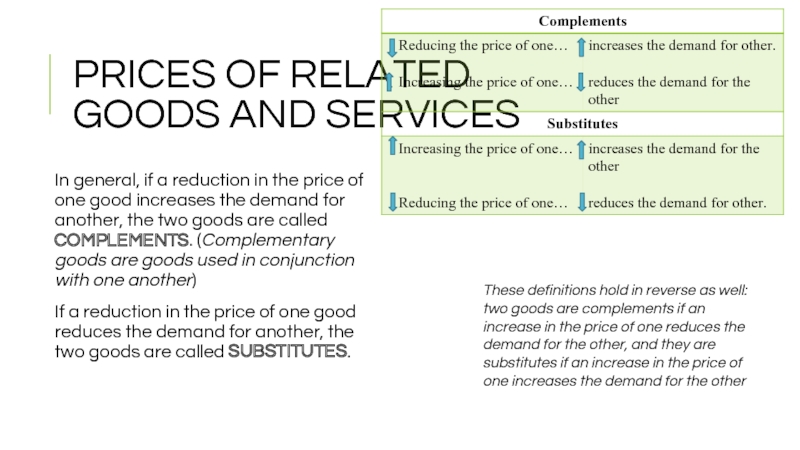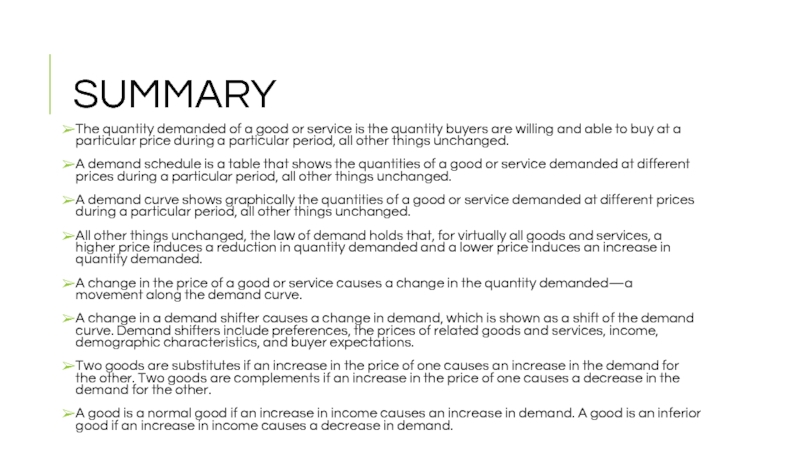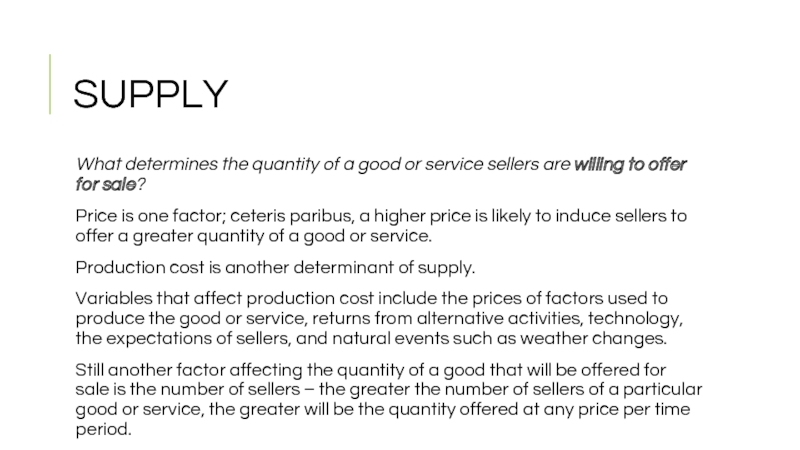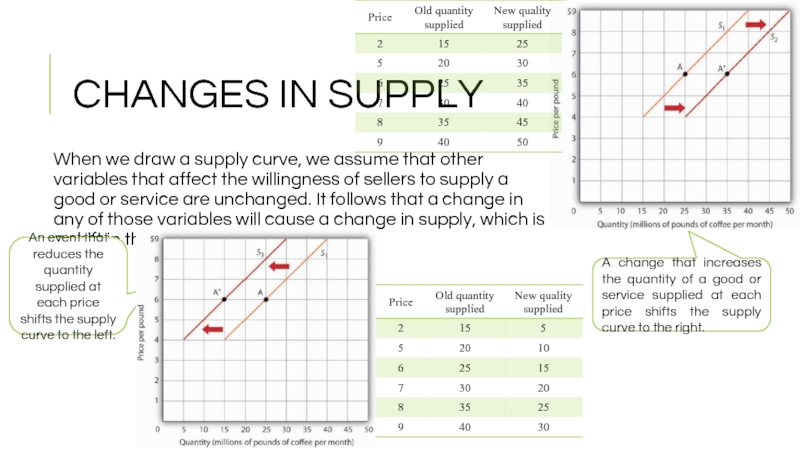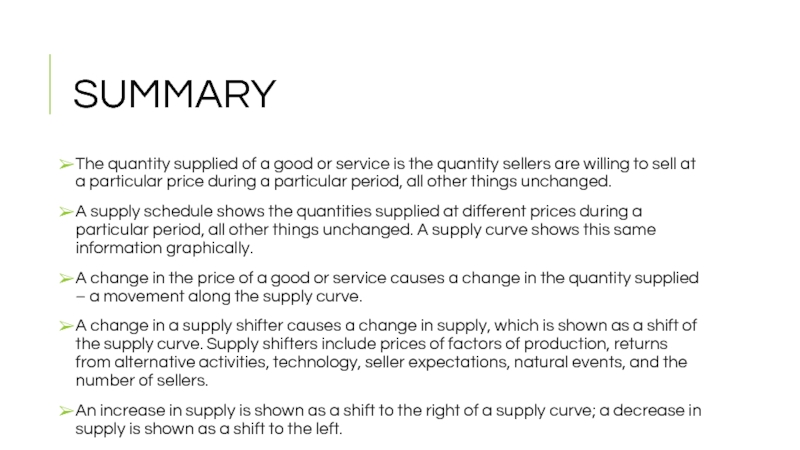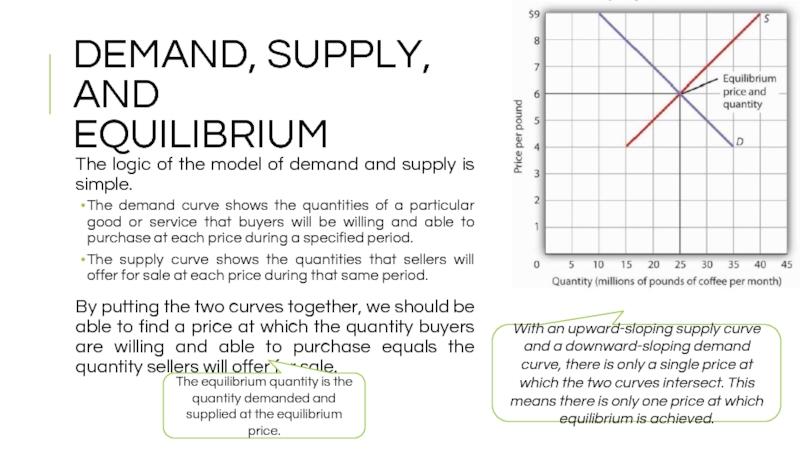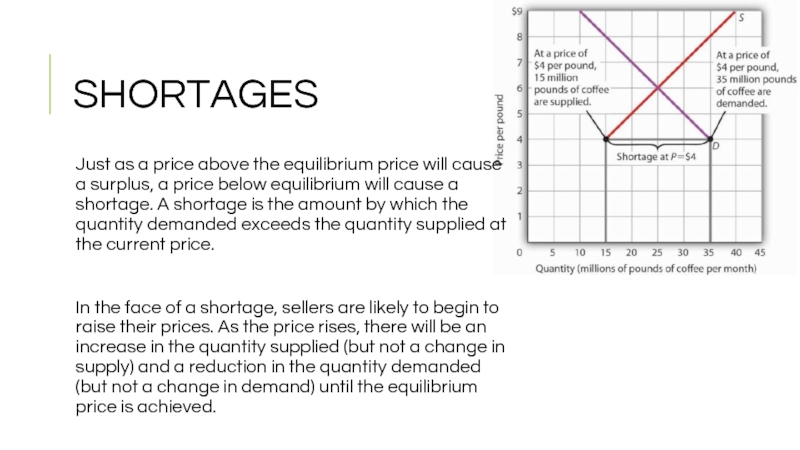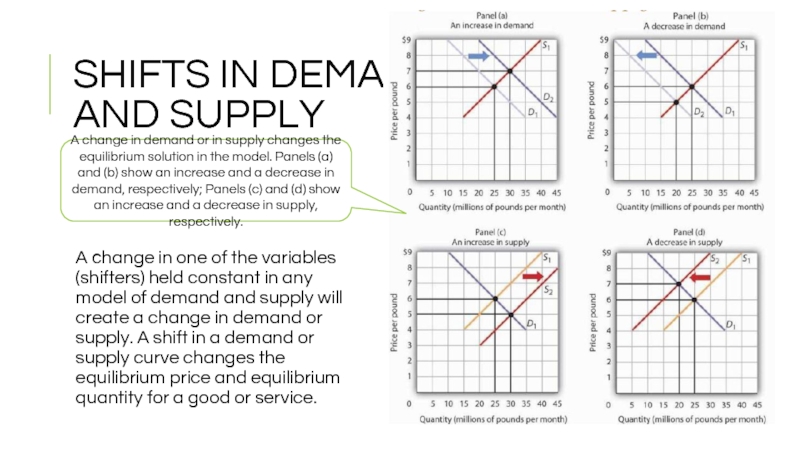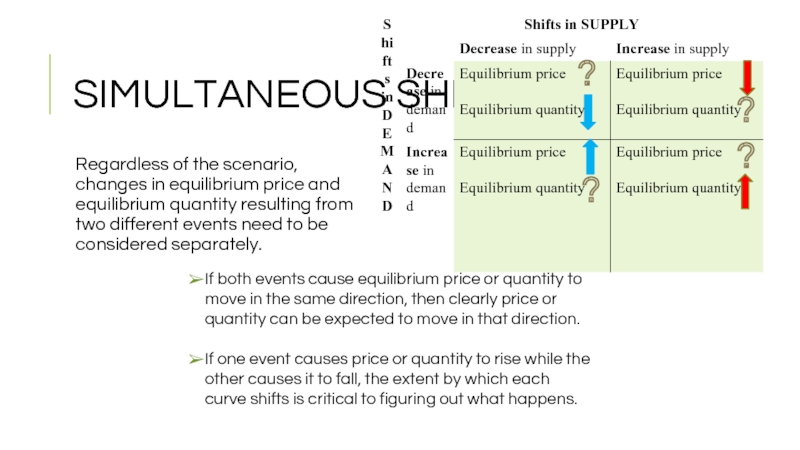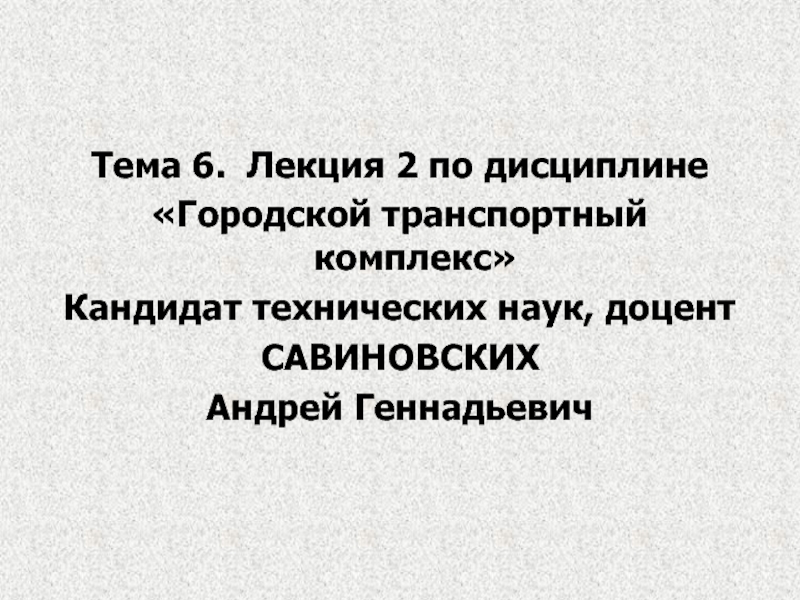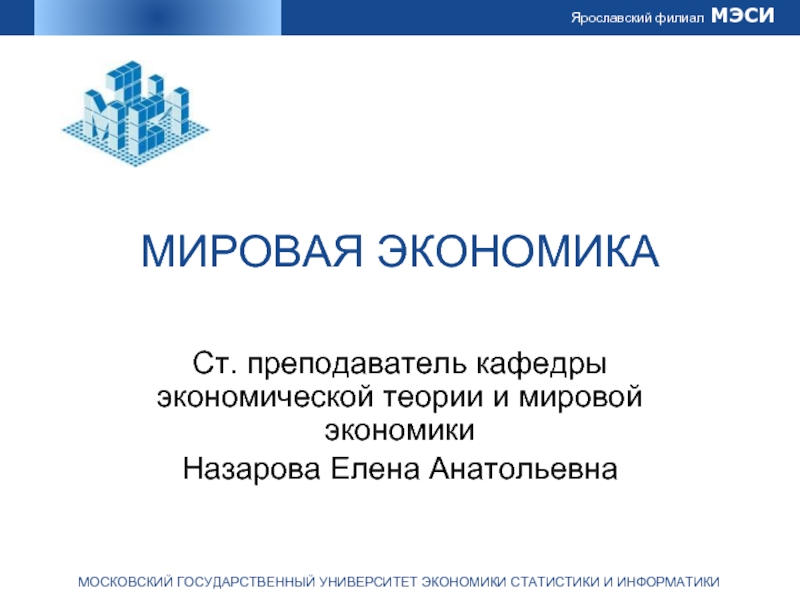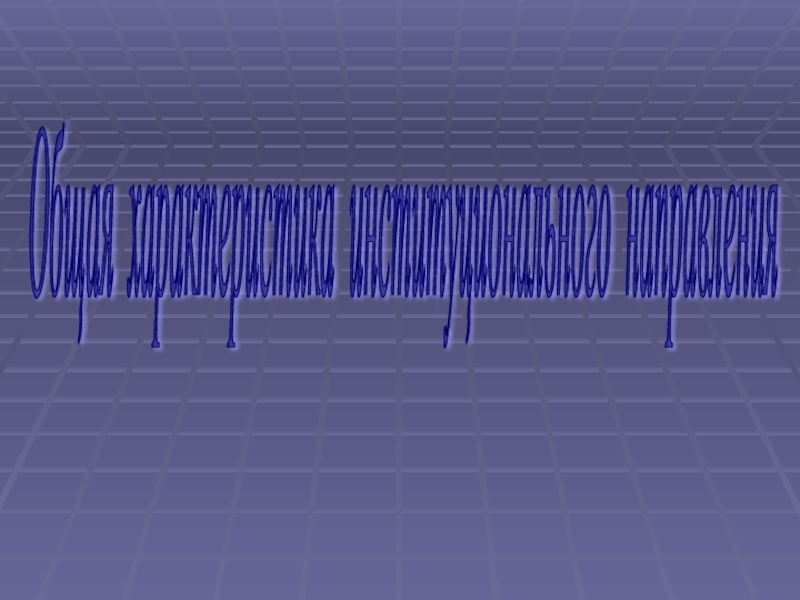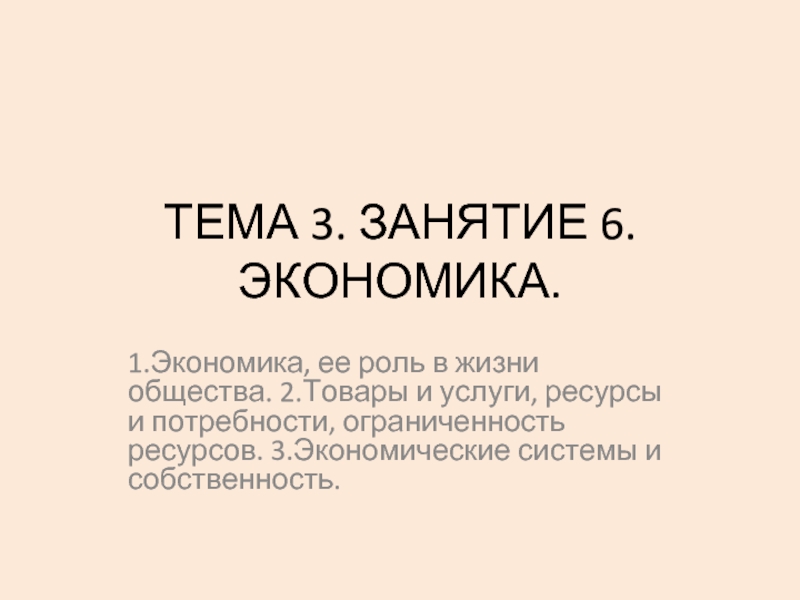- Главная
- Разное
- Дизайн
- Бизнес и предпринимательство
- Аналитика
- Образование
- Развлечения
- Красота и здоровье
- Финансы
- Государство
- Путешествия
- Спорт
- Недвижимость
- Армия
- Графика
- Культурология
- Еда и кулинария
- Лингвистика
- Английский язык
- Астрономия
- Алгебра
- Биология
- География
- Детские презентации
- Информатика
- История
- Литература
- Маркетинг
- Математика
- Медицина
- Менеджмент
- Музыка
- МХК
- Немецкий язык
- ОБЖ
- Обществознание
- Окружающий мир
- Педагогика
- Русский язык
- Технология
- Физика
- Философия
- Химия
- Шаблоны, картинки для презентаций
- Экология
- Экономика
- Юриспруденция
Supply and demand презентация
Содержание
- 1. Supply and demand
- 2. FACTORS OF PRODUCTION One thing that
- 3. SUMMARY Factors of production are the resources
- 4. DEMAND The quantity demanded of a good
- 5. DEMAND The information given in a demand
- 6. LAW OF DEMAND The negative slope of
- 7. CHANGES IN DEMAND Obviously, price alone
- 8. CHANGES IN DEMAND A reduction in demand
- 9. DEMAND SHIFTERS Preferences (Changes in preferences of
- 10. PRICES OF RELATED GOODS AND SERVICES
- 11. SUMMARY The quantity demanded of a good
- 12. SUPPLY What determines the quantity of a
- 13. PRICE AND SUPPLY CURVE The quantity supplied
- 14. CHANGES IN SUPPLY When we draw a
- 15. SHIFTS IN SUPPLY A variable that can
- 16. SUMMARY The quantity supplied of a good
- 17. DEMAND, SUPPLY, AND EQUILIBRIUM The
- 18. SURPLUSES A SURPLUS is the amount
- 19. SHORTAGES Just as a price above
- 20. SHIFTS IN DEMAND AND SUPPLY A change
- 21. SIMULTANEOUS SHIFTS Three panels of Figure
- 22. SIMULTANEOUS SHIFTS Regardless of the scenario,
Слайд 2FACTORS OF PRODUCTION
One thing that is not considered capital is
That requires knowledge; we must know how to use the things we find in nature before they become resources.
Слайд 3SUMMARY
Factors of production are the resources the economy has available to
Labor is the human effort that can be applied to the production of goods and services. Labor’s contribution to an economy’s output of goods and services can be increased either by increasing the quantity of labor or by increasing human capital.
Capital is a factor of production that has been produced for use in the production of other goods and services.
Natural resources are those things found in nature that can be used for the production of goods and services.
Two keys to the utilization of an economy’s factors of production are technology and, in the case of a market economic system, the efforts of entrepreneurs.
Слайд 4DEMAND
The quantity demanded of a good or service is the quantity
A demand schedule is a table that shows the quantities of a good or service demanded at different prices during a particular period, all other things unchanged.
Слайд 5DEMAND
The information given in a demand schedule can be presented with
A demand curve thus shows the relationship between the price and quantity demanded of a good or service during a particular period, all other things unchanged.
A change in price, with no change in any of the other variables that affect demand, results in a movement along the demand curve.
A movement along a demand curve that results from a change in price is called a change in quantity demanded. Change in quantity demanded is not a change or shift in the demand curve; it is a movement along the demand curve.
Слайд 6LAW OF DEMAND
The negative slope of the demand curve suggests a
LAW OF DEMAND holds that, for virtually all goods and services, a higher price leads to a reduction in quantity demanded and a lower price leads to an increase in quantity demanded (ceteris paribus).
The law of demand is called a law because the results of countless studies are consistent with it. Undoubtedly, you have observed one manifestation of the law. When a store finds itself with an overstock of some item, such as running shoes or tomatoes, and needs to sell these items quickly, what does it do? It typically has a sale, expecting that a lower price will increase the quantity demanded. In general, we expect the law of demand to hold. Given the values of other variables that influence demand, a higher price reduces the quantity demanded. A lower price increases the quantity demanded. Demand curves, in short, slope downward.
Слайд 7CHANGES IN DEMAND
Obviously, price alone does not determine the quantity
The shift In a demand curve is called a change in demand.
Coffee consumption, for example, will be affected by such variables as income and population. Preferences also play a role. We also expect other prices to affect coffee consumption. People often eat doughnuts or bagels with their coffee, so a reduction in the price of doughnuts or bagels might induce people to drink more coffee. An alternative to coffee is tea, so a reduction in the price of tea might result in the consumption of more tea and less coffee.
Слайд 8CHANGES IN DEMAND
A reduction in demand occurs when the quantities of
A variable that can change the quantity of a good or service demanded at each price is called a demand shifter. When these other variables change, the all-other-things-unchanged conditions behind the original demand curve no longer hold.
Although different goods and services will have different demand shifters, the demand shifters are likely to include (1) consumer preferences, (2) the prices of related goods and services, (3) income, (4) demographic characteristics, and (5) buyer expectations.
Note, again, that a change in quantity demanded, ceteris paribus, refers to a movement along the demand curve, while a change in demand refers to a shift in the demand curve.
Слайд 9DEMAND SHIFTERS
Preferences (Changes in preferences of buyers can have important consequences
Income (As incomes rise, people increase their consumption of many goods and services, and as incomes fall, their consumption of these goods and services falls)
A good for which demand increases when income increases is called a NORMAL GOOD.
A good for which demand decreases when income increases is called an INFERIOR GOOD.
Demographic Characteristics (The number of buyers affects the total quantity of a good or service that will be bought; in general, the greater the population, the greater the demand. Other demographic characteristics can affect demand as well)
Buyer Expectations (The consumption of goods that can be easily stored, or whose consumption can be postponed, is strongly affected by buyer expectations)
Слайд 10PRICES OF RELATED
GOODS AND SERVICES
In general, if a reduction in
If a reduction in the price of one good reduces the demand for another, the two goods are called SUBSTITUTES.
These definitions hold in reverse as well: two goods are complements if an increase in the price of one reduces the demand for the other, and they are substitutes if an increase in the price of one increases the demand for the other
Слайд 11SUMMARY
The quantity demanded of a good or service is the quantity
A demand schedule is a table that shows the quantities of a good or service demanded at different prices during a particular period, all other things unchanged.
A demand curve shows graphically the quantities of a good or service demanded at different prices during a particular period, all other things unchanged.
All other things unchanged, the law of demand holds that, for virtually all goods and services, a higher price induces a reduction in quantity demanded and a lower price induces an increase in quantity demanded.
A change in the price of a good or service causes a change in the quantity demanded—a movement along the demand curve.
A change in a demand shifter causes a change in demand, which is shown as a shift of the demand curve. Demand shifters include preferences, the prices of related goods and services, income, demographic characteristics, and buyer expectations.
Two goods are substitutes if an increase in the price of one causes an increase in the demand for the other. Two goods are complements if an increase in the price of one causes a decrease in the demand for the other.
A good is a normal good if an increase in income causes an increase in demand. A good is an inferior good if an increase in income causes a decrease in demand.
Слайд 12SUPPLY
What determines the quantity of a good or service sellers are
Price is one factor; ceteris paribus, a higher price is likely to induce sellers to offer a greater quantity of a good or service.
Production cost is another determinant of supply.
Variables that affect production cost include the prices of factors used to produce the good or service, returns from alternative activities, technology, the expectations of sellers, and natural events such as weather changes.
Still another factor affecting the quantity of a good that will be offered for sale is the number of sellers – the greater the number of sellers of a particular good or service, the greater will be the quantity offered at any price per time period.
Слайд 13PRICE AND SUPPLY CURVE
The quantity supplied of a good or service
Ceteris paribus, the receipt of a higher price increases profits and induces sellers to increase the quantity they supply.
The relationship between price and quantity supplied is suggested in a supply schedule, a table that shows quantities supplied at different prices during a particular period, all other things unchanged.
A supply curve is a graphical representation of a supply schedule. It shows the relationship between price and quantity supplied during a particular period, all other things unchanged.
Because the relationship between price and quantity supplied is generally positive, supply curves are generally upward sloping
A change in price causes a movement along the supply curve; such a movement is called a change in quantity supplied
Слайд 14CHANGES IN SUPPLY
When we draw a supply curve, we assume that
A change that increases the quantity of a good or service supplied at each price shifts the supply curve to the right.
An event that reduces the quantity supplied at each price shifts the supply curve to the left.
Слайд 15SHIFTS IN SUPPLY
A variable that can change the quantity of a
prices of factors of production,
returns from alternative activities (To produce one good or service means forgoing the production of another. The concept of opportunity cost),
technology,
seller expectations,
natural events,
the number of sellers.
Слайд 16SUMMARY
The quantity supplied of a good or service is the quantity
A supply schedule shows the quantities supplied at different prices during a particular period, all other things unchanged. A supply curve shows this same information graphically.
A change in the price of a good or service causes a change in the quantity supplied – a movement along the supply curve.
A change in a supply shifter causes a change in supply, which is shown as a shift of the supply curve. Supply shifters include prices of factors of production, returns from alternative activities, technology, seller expectations, natural events, and the number of sellers.
An increase in supply is shown as a shift to the right of a supply curve; a decrease in supply is shown as a shift to the left.
Слайд 17DEMAND, SUPPLY, AND
EQUILIBRIUM
The logic of the model of demand
The demand curve shows the quantities of a particular good or service that buyers will be willing and able to purchase at each price during a specified period.
The supply curve shows the quantities that sellers will offer for sale at each price during that same period.
By putting the two curves together, we should be able to find a price at which the quantity buyers are willing and able to purchase equals the quantity sellers will offer for sale.
The equilibrium quantity is the quantity demanded and supplied at the equilibrium price.
With an upward-sloping supply curve and a downward-sloping demand curve, there is only a single price at which the two curves intersect. This means there is only one price at which equilibrium is achieved.
Слайд 18SURPLUSES
A SURPLUS is the amount by which the quantity supplied
There is no surplus at the equilibrium price; a surplus occurs only if the current price exceeds the equilibrium price.
Слайд 19SHORTAGES
Just as a price above the equilibrium price will cause
In the face of a shortage, sellers are likely to begin to raise their prices. As the price rises, there will be an increase in the quantity supplied (but not a change in supply) and a reduction in the quantity demanded (but not a change in demand) until the equilibrium price is achieved.
Слайд 20SHIFTS IN DEMAND AND SUPPLY
A change in one of the variables
A change in demand or in supply changes the equilibrium solution in the model. Panels (a) and (b) show an increase and a decrease in demand, respectively; Panels (c) and (d) show an increase and a decrease in supply, respectively.
Слайд 21SIMULTANEOUS SHIFTS
Three panels of Figure show a decrease in demand
Since decreases in demand and supply, considered separately, each cause equilibrium quantity to fall, the impact of both decreasing simultaneously means that a new equilibrium quantity be less than the old equilibrium quantity.
In Panel (a), the demand curve shifts farther to the left than does the supply curve, so equilibrium price falls.
In Panel (b), the supply curve shifts farther to the left than does the demand curve, so the equilibrium price rises.
In Panel (c), both curves shift to the left by the same amount, so equilibrium price stays the same.
Simultaneous Decreases in Demand and Supply
Слайд 22SIMULTANEOUS SHIFTS
Regardless of the scenario, changes in equilibrium price and
?
?
?
?
If both events cause equilibrium price or quantity to move in the same direction, then clearly price or quantity can be expected to move in that direction.
If one event causes price or quantity to rise while the other causes it to fall, the extent by which each curve shifts is critical to figuring out what happens.

